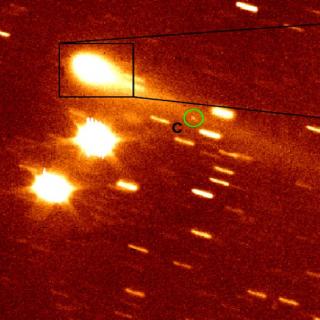Bibcode
Zanotti, G.; Zannoni, M.; Tusberti, F.; Pirrotta, S.; Tortora, P.; Modenini, D.; Lombardo, M.; Manghi, R. Lasagni; Lavagna, M.; Impresario, G.; Gomez-Casajus, L.; Gramigna, E.; Cremonese, G.; Gai, I.; Ceresoli, M.; Capannolo, A.; Caporali, S.; Rivkin, A. S.; Amoroso, M.; Bertini, I.; Kareta, T.; Moskovitz, N.; Chabot, N. L.; Thomas, C. A.; de León, J.; Della Corte, V.; Zinzi, A.; Brucato, J. R.; Palumbo, P.; Ivanovski, S. L.; Rossi, A.; Lucchetti, A.; Pajola, M.; Perna, D.; Dall'Ora, M.; Poggiali, G.; Hasselmann, P. H.; Petropoulou, V.; Deshapriya, J. D. P.; Mazzotta Epifani, E.; Dotto, E.; Ieva, Simone
Bibliographical reference
The Planetary Science Journal
Advertised on:
10
2024
Citations
0
Refereed citations
0
Description
We spectroscopically characterized the Didymos system, target of the Double Asteroid Redirection Test (DART)/Light Italian Cubesat for Imaging of Asteroids (LICIACube) space mission, close in time to the DART impact event, during six nights between 2022 August and November at Telescopio Nazionale Galileo. Here, we show that near-infrared (NIR) spectra (0.75–2.25 μm) look mostly similar within the same night and between different nights. They are in good agreement with the only spectrum previously available in the literature, observed almost 20 years before those reported in this paper. During one of the observing nights we also obtain spectroscopy information on the ejecta tail induced by the DART impact. The spectrum of the ejecta tail is also very similar to Didymos/Dimorphos itself. All of these aspects seem to suggest that the Didymos system in the NIR looks mostly homogeneous, with very subtle spectral variations. * Based on observations made with the Italian Telescopio Nazionale Galileo (TNG) operated on the island of La Palma by the Fundación Galileo Galilei of the Istituto Nazionale di Astrofisica (INAF) at the Spanish Observatorio del Roque de los Muchachos of the Instituto de Astrofisica de Canarias (Program AOT45-TAC8 and AOT46-TAC19).
Related projects

Minor Bodies of the Solar System
This project studies the physical and compositional properties of the so-called minor bodies of the Solar System, that includes asteroids, icy objects, and comets. Of special interest are the trans-neptunian objects (TNOs), including those considered the most distant objects detected so far (Extreme-TNOs or ETNOs); the comets and the comet-asteroid
Julia de
León Cruz